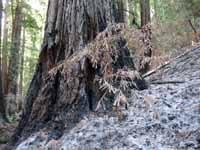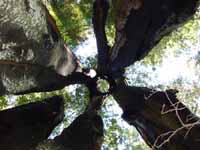|
COAST REDWOOD UPDATE
20 Aug 2009
A newly published synthesis of disturbance regimes in coast redwood and their ecological effects has been published in Forest Ecology and Management. You can find it here:
ABSTRACT: Coast redwood ( Sequoia sempervirens ), a western North American conifer of ancient lineage, has a paradoxical combination of late-successional characteristics and strong adaptations to disturbance. Despite its shade tolerance and heavy dominance of the canopy on many sites, redwood saplings are uncommon in upland old-growth stands. Information needed to ensure the conservation of old-growth redwood forests has been limited. In this review paper, we integrate evidence on redwood biology with data on the historic and modern disturbance regimes to help clarify the degree to which key attributes of redwood forests may have been dependent upon periodic disturbance. Available evidence suggests that episodes of fire, flooding, and slope failure prior to European settlement were frequent but predominantly of low to moderate severity and extent, resulting in broadly uneven-aged forests. The majority of fires prior to European settlement were apparently of human origin. Frequency and severity of the major disturbance agents have been radically changed in modern times. Fires have been largely excluded, and flooding has been altered in ways that have often been detrimental to old-growth redwoods on alluvial terraces. However, because of the apparent anthropogenic origin of most presettlement fires, the long-term evolutionary role of fire for coast redwood is ecologically ambiguous. With fire exclusion, redwood possibly could be displaced to some extent on upland sites by increasing abundance of fire-sensitive competitors. Alternatively, redwood may be able to maintain dominance by vegetative sprouting and new seedling establishment on root-wad mounds, fallen logs, and on soil exposed by slope failure. Future research priorities are suggested that will help resolve some of the current ambiguities.
Keywords: age structure, fire regimes, fire suppression, flooding, forest succession, gap dynamics, sequoia semprvirens, windstorms
___________
13 Oct 2008
I've uploaded a short video documenting the Bald Hills prescribed fire that occurred this past September to the Bald Hills Fire Management webpage. The Schoolhouse burn unit in Redwood National Park is a sweet unit because it includes both Oregon white oak forest and grassland and it is important for broader-scale fire management. In a month I will add some footage of fire behavior in the oak forest on the north side.

___________
October 6, 2008
I spent this past month on the north coast revisiting the Canoe fire (5-year anniversary of the burn). I was shocked by the lack of seeding redwood. The jubata grass seems to have seeded in more than we had hoped too. I spent two days exploring fire effects at Montgomery Woods Reserve. It burned this past summer. You can see a webpage about my impression of that stunning early season fire HERE.

___________
August 1, 2008
The coast redwood ecology and management website is now official. I hope that it can become an active environment for synthesizing a wide range of coast redwood management issues, particularly fire ecology and management issues.

|
|

